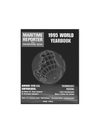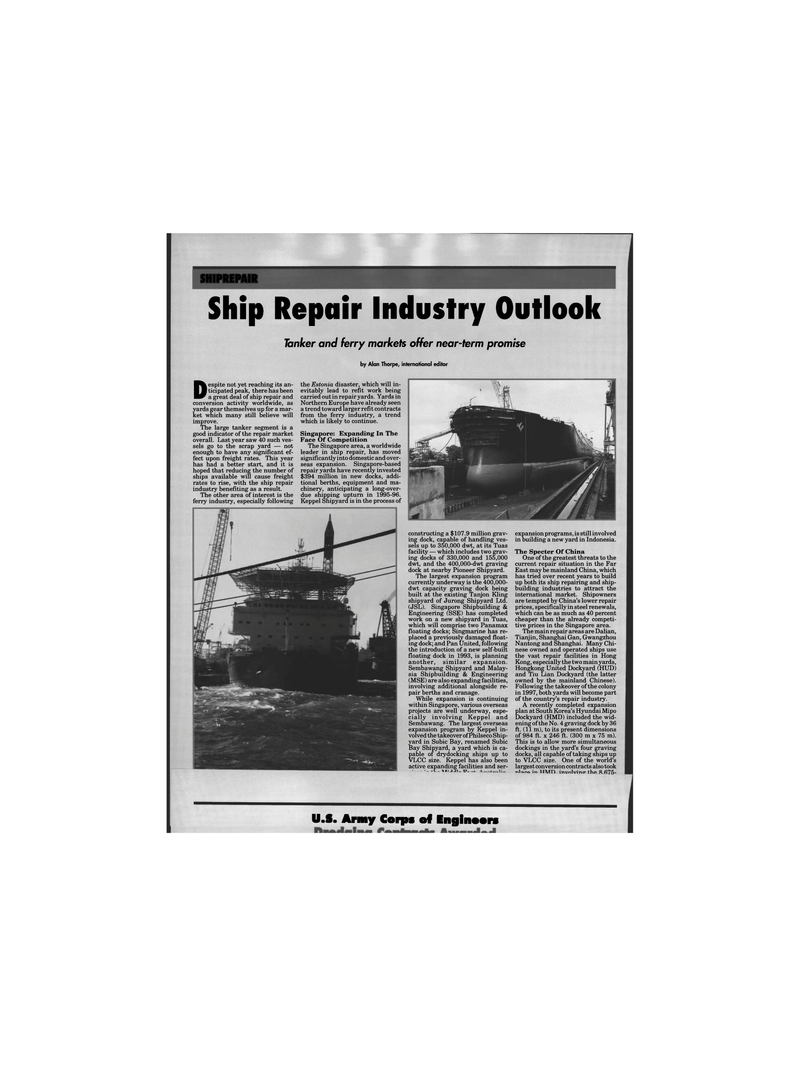
Page 60: of Maritime Reporter Magazine (June 1995)
Read this page in Pdf, Flash or Html5 edition of June 1995 Maritime Reporter Magazine
SHIPREPAIR
Despite not yet reaching its an-ticipated peak, there has been a great deal of ship repair and conversion activity worldwide, as yards gear themselves up for a mar- ket which many still believe will improve.
The large tanker segment is a good indicator of the repair market overall. Last year saw 40 such ves- sels go to the scrap yard — not enough to have any significant ef- fect upon freight rates. This year has had a better start, and it is hoped that reducing the number of ships available will cause freight rates to rise, with the ship repair industry benefiting as a result.
The other area of interest is the ferry industry, especially following constructing a $107.9 million grav- ing dock, capable of handling ves- sels up to 350,000 dwt, at its Tuas facility — which includes two grav- ing docks of 330,000 and 155,000 dwt, and the 400,000-dwt graving dock at nearby Pioneer Shipyard.
The largest expansion program currently underway is the 400,000- dwt capacity graving dock being built at the existing Tanjon Kling shipyard of Jurong Shipyard Ltd. (JSL). Singapore Shipbuilding &
Engineering (SSE) has completed work on a new shipyard in Tuas, which will comprise two Panamax floating docks; Singmarine has re- placed a previously damaged float- ing dock; and Pan United, following the introduction of a new self-built floating dock in 1993, is planning another, similar expansion.
Sembawang Shipyard and Malay- sia Shipbuilding & Engineering (MSE) are also expanding facilities, involving additional alongside re- pair berths and cranage.
While expansion is continuing within Singapore, various overseas projects are well underway, espe- cially involving Keppel and
Sembawang. The largest overseas expansion program by Keppel in- volved the takeover of Philseco Ship- yard in Subic Bay, renamed Subic
Bay Shipyard, a yard which is ca- pable of drydocking ships up to
VLCC size. Keppel has also been active expanding facilities and ser- • 11- - Hfjjju TP, expansion programs, is still involved in building a new yard in Indonesia.
The Specter Of China
One of the greatest threats to the current repair situation in the Far
East may be mainland China, which has tried over recent years to build up both its ship repairing and ship- building industries to attract the international market. Shipowners are tempted by China's lower repair prices, specifically in steel renewals, which can be as much as 40 percent cheaper than the already competi- tive prices in the Singapore area.
The main repair areas are Dalian,
Tianjin, Shanghai Gan, Gwangzhou
Nantong and Shanghai. Many Chi- nese owned and operated ships use the vast repair facilities in Hong
Kong, especially the two main yards,
Hongkong United Dockyard (HUD) and Tiu Lian Dockyard (the latter owned by the mainland Chinese).
Following the takeover of the colony in 1997, both yards will become part of the country's repair industry.
A recently completed expansion plan at South Korea's Hyundai Mipo
Dockyard (HMD) included the wid- ening of the No. 4 graving dock by 36 ft. (11 m), to its present dimensions of 984 ft. x 246 ft. (300 m x 75 m).
This is to allow more simultaneous dockings in the yard's four graving docks, all capable of taking ships up to VLCC size. One of the world's largest conversion contracts also took "li™ in WMF) invnlvincr t.Hfi 8.675-
U.S. Army Corps of Engineers
Ship Repair Industry Outlook
Tanker and ferry markets offer near-term promise by Alan Thorpe, international editor the Estonia disaster, which will in- evitably lead to refit work being carried out in repair yards. Yards in
Northern Europe have already seen a trend toward larger refit contracts from the ferry industry, a trend which is likely to continue.
Singapore: Expanding In The
Face Of Competition
The Singapore area, a worldwide leader in ship repair, has moved significantly into domestic and over- seas expansion. Singapore-based repair yards have recently invested $394 million in new docks, addi- tional berths, equipment and ma- chinery, anticipating a long-over- due shipping upturn in 1995-96.
Keppel Shipyard is in the process of

 59
59

 61
61
